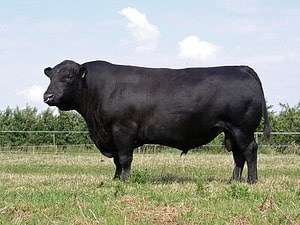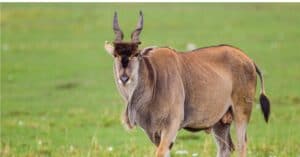Cows have been domesticated for over 10,000 years. They’re cloven hooved herbivores of the Bovidae family. We use them for everything from meat to milk to leather. They’re raised all over the world, and can survive in diverse habitats. Some even weigh up to 3,000 pounds, and live for decades.
With all of that weight, it leaves one wondering; just what do a cow’s teeth look like? Here, we’ll answer that question, as well as many more. We’ll take a closer look at the teeth of calves and how they change in adulthood. Then, we’ll learn how to tell a cow’s age from its teeth, and whether or not cows can bite.
Milk teeth: A Calf’s First Teeth
Calves are born in ones and twos after a nine month gestation. The first teeth they get are their lower incisors. All calves have 20 teeth; eight incisors and 12 premolars. As they get older, their permanent teeth start growing in and replacing the deciduous (baby) teeth one pair at a time.
Young cows don’t get their first permanent tooth until they’re about two years old. At that time, the first adult teeth to come in are the lower middle incisors, sometimes called pincers. Then come the first intermediate incisors (the next pair to the sides of the central incisors) at three years of age. At four years old they get their third pair of adult teeth, the second intermediate incisors.
Around five years of age calves get their final set of incisors, the corner incisors. During this time, they also get their adult cheek teeth, though these are farther back in the mouth, and harder to see.
Do Cows Have Upper Teeth?
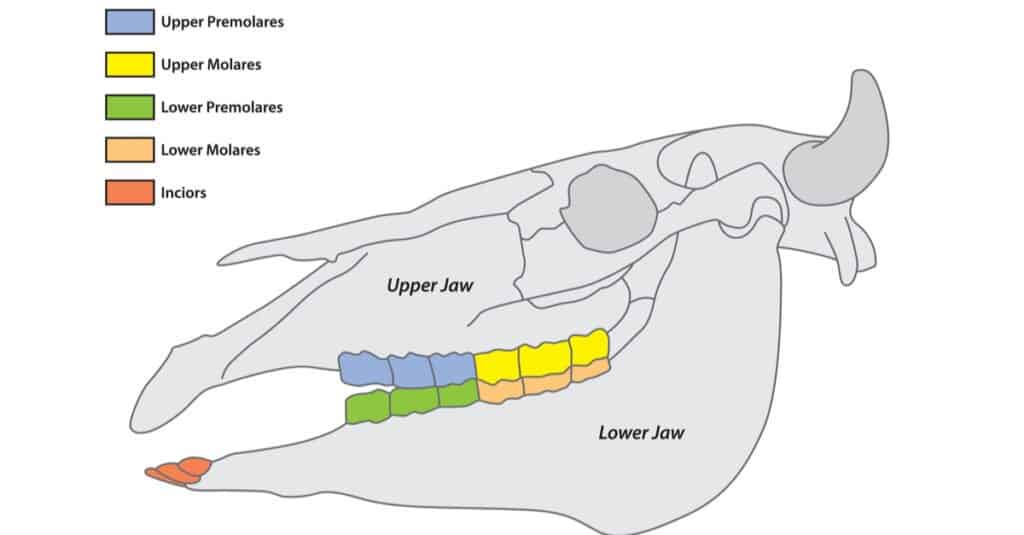
Cows don’t have upper incisors; instead they have a hard dental pad for chewing
©Rainer Lesniewski/Shutterstock.com
Cows do have upper teeth, however they only grow incisors on their lower jaw. Let’s dive into why this is the case.
The reason for this is simple; cows are ruminants, (like sheep and goats) and ruminants grow a hard, fleshy mound called a dental pad in place of upper incisors. When they chew tough foods like grass and forbs, they rub them between the bottom incisors and the dental pad. This makes for a very effective shredding mechanism. Because of this, cows have no front teeth; at least on top.
However, while cows lack incisors on their upper jaw (see diagram above), they do have upper premolars and molars. When cows “chew the cud” – burp grass back into their mouth for a second digestion – these upper teeth are used to further break grasses down into smaller pieces.
Can Cows Bite?
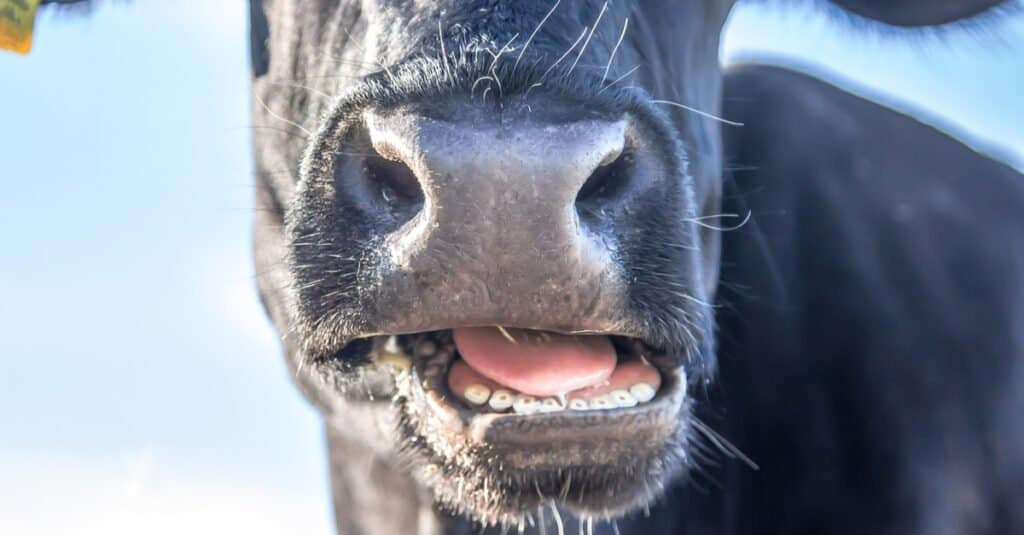
Cows have 32 teeth in total.
©Vladimir Konstantinov/Shutterstock.com
Theoretically, all animals with mouths and teeth can bite. But, if a cow bites you, is it the same as when a dog bites you?
The easy answer is–no. Cows can bite you, but because they have no top teeth at the front of their mouth, the most they can do is leave you with a good bruise or pinch.
A cow’s main defense comes from its size, and its hooves. Bulls also have their horns, and will chase down threats. But not to worry, if a cow (or even a bull) bites you, chances are they won’t do much damage.
Adult teeth: How Many Teeth Do Cows Have?
Adults cows have 32 teeth in total; eight incisors, 12 premolars, and 12 molars. They use their teeth almost exclusively for eating the vegetation they depend on. This is particularly important for cows, who have four part stomachs that require a lot of chewing.
When a cow eats, it first swallows and partially digests its food in one of its stomach chambers. Then, it regurgitates this food, chews it again, and swallows it–again. This process can happen many times; it’s vital for the cow’s digestion that it be able to pulp its meals into tinier and tinier pieces.
Let’s take a closer look at the teeth that allow cows to have such complex digestion systems.
Incisors
Cows have only eight incisors, all on the bottom jaw. They don’t have true canines, though some people call their corner incisors their canines. Incisors are important for pulling grasses and other plants into the mouth, as well as giving them the initial chop. Together with the stiff upper lip and mobile tongue, the cow’s incisors pull food into the mouth, and begin breaking it up.
Premolars

Cows have molars that are used for grinding grass down.
©wasanajai/Shutterstock.com
After the incisors, there is a large, toothless gap in the cow’s mouth called a diastema. The premolars are located far back in the mouth, and are much more robust than the incisors. They have high crowns that run laterally from tongue to cheek, giving the teeth a mountain and valley appearance when viewed from the side. Along with the molars, premolars are essential for grinding up the tough food cows thrive on.
Molars
The final tooth in the cow’s mouth is the molar. This is the biggest, strongest tooth cows have, and it does the bulk of the grinding work. Like the premolars, molars have high crowns designed for masticating hard to eat vegetation. Cows chew in a distinctive side to side motion, when they do this, they’re actually dragging food across their cheek teeth. As they chew, the high crowns effectively shred and grind up the food, readying it for its first, second, or third digestion.
Determining a Cow’s Age From Teeth
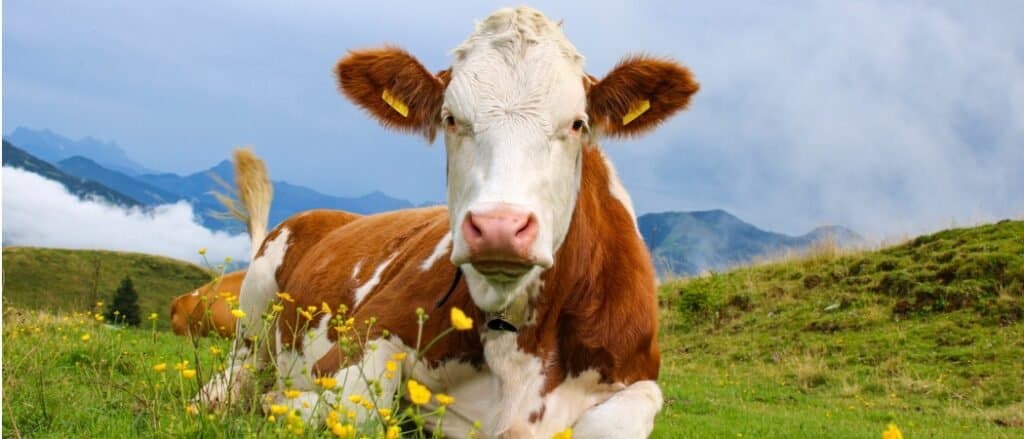
The older the cow, the more worn and discolored the teeth
©Flying broccoli/Shutterstock.com
Because cow’s front teeth always erupt in the same order, cow owners and veterinarians can use them to accurately determine the cow’s age. The adult teeth are much bigger and more robust than the baby teeth, and the two are easily distinguishable.
To begin; if a cow has no adult teeth, it’s under two years old. If it has a single pair of adult teeth at the center of its mouth, then it’s between two and three years old. Two pairs of adult incisors (four total) means the cow is at least three years old. At four years old they get their third pair of adult incisors, and by five they have no baby teeth left at all.
Cows’ teeth don’t last terribly long. If they make it to ten years, chances are they have severely worn incisors, and may even be missing teeth. This can make eating difficult, or even impossible.
The photo featured at the top of this post is © Vladimir Konstantinov/Shutterstock.com
Thank you for reading! Have some feedback for us? Contact the AZ Animals editorial team.




